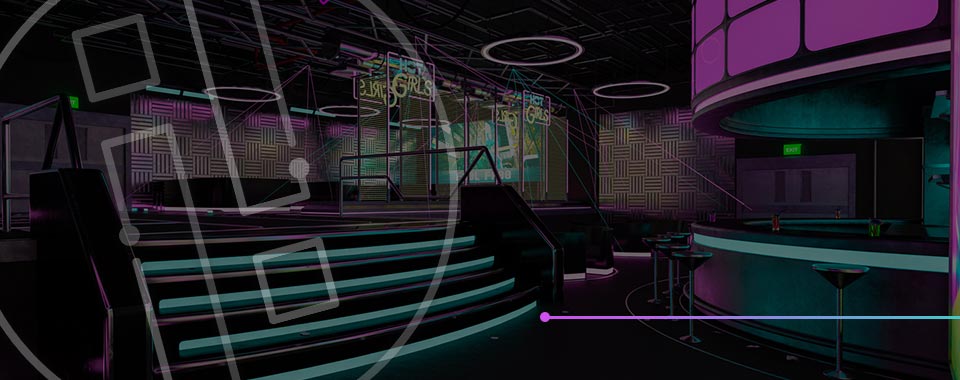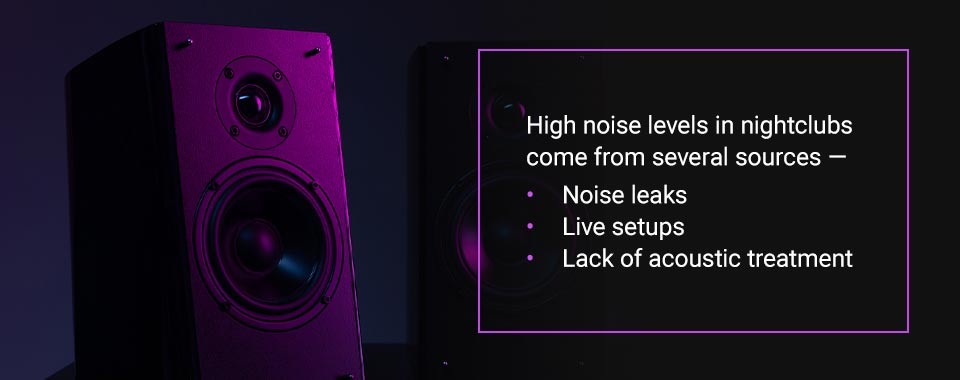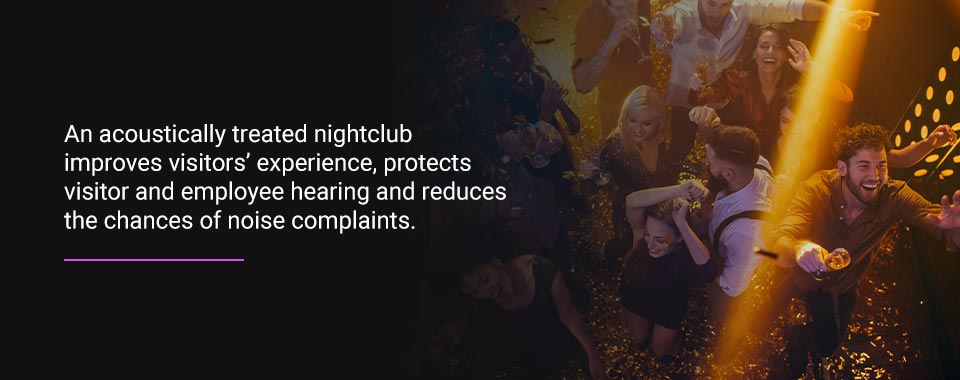

Sound quality is essential for the experience people have in your nightclub. If you have problems with excess noise, complaints from neighbors or hearing problems from patrons, you need to reassess your acoustics. Changing how sound travels inside your venue can dramatically improve the impressions your patrons and neighbors have of your nightclub.
Sound is measured in decibels (dBA). Excessive noise can harm hearing from a single experience hearing a sound at 140 dBA. This sound level is similar to being close to a plane taking off. Even low-level exposure for an extended time can damage hearing. Constantly hearing sounds of 70 dBA or louder can contribute to hearing problems. The noise levels in clubs regularly reach 110 dBA, and live music performers may create sounds of 120 dBA or higher.
Too much noise makes nightclubbing no longer fun. Customers shout to be heard by each other, and ears ring at the end of the evening. Fixing the problem starts with identifying the most common causes of the excess sound in your business. High noise levels in nightclubs come from several sources — noise leaks, live setups and lack of acoustic treatment.

Sound travels through the air and surfaces. Where air can leak in your club, you can also have noise leaking out. One way to search for potential sources of noise leaks is to turn off the lights at night and look for places around the building where exterior light seeps inside.
Frequent sources of noise leaks include around windows, through single-pane windows, near door frames, through open doors and around leaky gaskets. Thin ceilings, floors and walls that don’t absorb soundwaves can also transmit the noise outside your club. Air vents are another way for sound to sneak out of your nightclub due to their ability to carry air and their metal construction, which vibrates easily.
Sealing off the noise leaks, padding air vents, using two sets of doors to keep one closed and installing double-pane windows can mitigate some noise leaks. Covering walls, floors and ceilings with a selection of acoustic panels or vibration-absorbing pads can also minimize the sound passing through these areas.
Live setups can contribute to too much noise in your club. The stage and speakers can vibrate too much, causing excessive noise that prevents clearly hearing the music. For live setups, the performers may play at higher decibel levels than usual or have a significant variation in the sound levels they produce.
Controlling sound for live sets is more difficult due to the unpredictability of the noise levels, but it is not impossible. Good communications and proper setup of the stage and speakers can keep noise from reaching dangerous levels.
Not having acoustic treatment inside your nightclub will contribute to sound poorly traveling through the building and seeping outside where the neighbors can hear it. Bad acoustics can contribute to patrons not being able to hear the music well or talk to each other.
Good acoustic treatment regulates the sound levels to make nightclubbing an enjoyable experience for anyone who visits without being too quiet or boring.

An acoustically treated nightclub improves visitors’ experience, protects visitor and employee hearing and reduces the chances of noise complaints. Everyone is happier — patrons, employees and neighbors — when noise levels are under control inside the nightclub. Plus, greater satisfaction can reduce employee turnover and potentially increase visitors to the location.
Visitors who go to clubs with poor acoustics don’t have the fun nights they expect. They need to shout to be heard by others in their party. The servers or bartender may not understand their orders, making mistakes in getting their drinks. The patrons may also not be able to hear the music clearly.
After leaving the club, patrons may have ringing in their ears or headaches from the noise. Ringing in the ears could indicate tinnitus triggered by excessive noise. You can prevent such health problems in your patrons by reducing the sound levels in the nightclub.
Employees deserve to work in an environment that protects their health and safety. The National Institute for Occupational Safety and Health (NIOSH) recommends 85 dBA as the exposure limit for noise during an eight-hour workday. However, different agencies present varying recommendations for noise exposure. For example, the Occupational Safety and Health Administration (OSHA) puts the eight-hour exposure level at 90 dBA. These recommendations come with time limits. Higher noise levels have lower maximum time limits for exposure without protection. For instance, OSHA limits 115 dBA sounds to no more than 15 minutes, while NIOSH puts the 15-minute limit on sounds of 100 dBA.
If your nightclub produces sound above these levels, take steps to improve the acoustics and reduce noise. Offer earplugs to workers, such as specialty musician earplugs that soften noises reaching the ears without blocking out all sound. Your servers and bartenders will still be able to communicate with patrons while protecting their hearing throughout their shifts.
Taking these steps can improve your employees’ health and wellbeing. Plus, by protecting their health and safety, you avoid problems with regulatory agencies that limit noise levels for workers.
Neighbors complaining of too much noise from a nightclub are not just being difficult. Excessively loud sounds can contribute to health problems beyond hearing damage.
A study of people living near airports found that the sound of planes taking off disrupted the daily activities and sleep of people in neighboring areas. Additionally, airport neighbors were more likely to report poorer health than those not bothered by noise.
By improving your nightclub’s acoustics, you reduce the impact your facility will have on your neighbors’ mental and physical health. Additionally, you’ll lower the chances of having people complaining about the noise from your club.

When it comes to treating your nightclub acoustically, you have several options. Using multiple methods to soften sounds, prevent echoes and reduce transmission of the sound outside the building will have the most significant effect. Examine the surfaces of your club and find ways to improve them to reduce excessive noise.
When it comes to acoustic treatment of your club, you have three methods — reduce noise, absorb and dampen sound or decouple the outside from the sound source. The best options depend on your budget, building design, and level of noise.
Reducing noise starts with lowering the volume produced by regulating volume levels on speakers. Turning down the volume is the simplest way to prevent noise levels from getting too high in a nightclub. However, only cutting sound levels does not prevent the spread of the sound away from the source or poor acoustics.
The next method of acoustic treatment involves absorbing and dampening excessive sound levels. Absorbing uses soft materials to absorb extra sound. These materials may include vibration pads, acoustic tiles or sound-absorbing baffles hanging from the ceiling. Dampening involves installing heavy materials that do not vibrate easily from sound waves. Replacing thin walls with thicker ones or installing heavier doors or double-pane windows are dampening options.
Decoupling separates the source of the sounds from the outside with an air barrier. The simplest example of decoupling is by building a room within a room. The air between the walls creates a sound barrier to keep noise from the inner room from reaching the outside. Instead of doing this in your nightclub, you can install a second set of doors or place another set of walls on the interior of your nightclub with acoustic material between the walls to reduce sound transmission outside.
Softening sound at the source is one way to reduce excessive noise. If you have a live band performing on a hollow stage, a simple way to lower the sound levels is to fill the space under the stage. Using panels under the stage to absorb sound and putting a sound absorption mat under the band can lower the extra sound rebounding off the stage.
Speakers installed on walls in your club will cause the walls to vibrate. Placing the speakers on vibration-absorbing pads on the floor can reduce the extra noise caused by wall-installed speakers. This method of reducing vibrations helps to reduce noise in the club.
To prevent noise from reaching dangerously high levels, regardless of the performer, use decibel limiters on the speakers to automatically regulate the sound levels coming from the speakers. This option works well if you have a DJ who may play music at various volume levels. The decibel limiter allows the volume variation without surpassing safe sound levels.
Bare, hard walls can cause echoes as sound bounces off them, raising noise levels. You can prevent this from happening while improving the appearance of your club.
To absorb sound hitting the walls, install a second layer of drywall over an existing wall with insulation between them. The extra drywall increases the mass of the walls. Heavier walls don’t vibrate and transmit sound as readily as thin, lightweight walls do.
Another way to improve acoustics on the walls is by installing acoustic panels. These softer panels absorb excessive noise and prevent echoes with their softer texture and uneven surfaces. You can choose from high-density acoustic panels or decorative options to reduce noise in your club. Look for a sound transmission class (STC) of 60 to prevent most sounds from passing through.
If you already have décor on your walls, boost the amount of insulation between walls. This step creates a dampening zone to absorb sound in the insulating material. Plus, your building will have better climate control because hot and cold air from outside won’t have as great of an impact on the internal temperature.
Open doors are an easy way for sound to leave your club. Plus, the open doors let in hot or cold air from outside. Instead of closing off your club to patrons, install a second set of doors. Keep the inner doors closed while allowing the outer ones to stay open for people to enter. The air space between the doors will reduce the amount of noise getting outside.
Another option for doors, including doors leading to restrooms, kitchens and employee areas, is installing acoustic doors with soundproofing material. These doors reduce sound leaving the main areas of your club.
While you may not have upstairs neighbors, sound can still leave your building to impact others outside through the ceiling. Plus, the ceiling could create an echo that distorts sounds and makes for a poor experience for the patrons.
Many nightclubs use drop ceilings with acoustic tiles to create a barrier between the levels. This system will only work if the panels are in place and don’t have sound leaks.
Another option for ceilings that helps reduce echoes is installing echo absorbers such as ceiling clouds. These give your nightclub a distinctive look while using a lower-cost alternative for preventing echoes. The lightweight cotton material works well at breaking up the expanse of a large, flat ceiling to stop sound from bouncing off the ceiling.
Baffles hung from the ceiling also break up the sound by creating an uneven area where sound has trouble passing through. These break up sound waves and absorb some while reducing echoes.
The floor is another place where you can do a lot to reduce echoes and noise levels. Install carpeting in areas of the club where you can. While carpet does well at absorbing noise, it does not make for a good dance floor. Another option is adding mass to the floors by installing a second layer over the base floor with insulation between the layers. You may consider this option to insulate the space between the dance floor area and the standard floor.
Large windows that look out to the street can draw in foot traffic by showing the patrons inside your club. However, these windows can also allow sound to leak out. If you have an older nightclub, the windows may be single-pane, which only has one layer of glass. These windows let more sound outside than double-pane windows, which have a layer of air between them.
Upgrading to new double- or triple-pane windows will both improve sound inside your club and energy efficiency. If your building won’t allow such an upgrade, install heavy curtains to the floor or window inserts to reduce sounds from leaking out of the windows to the outside. These installations also lower the chances of sound bouncing off the windows and echoing.
Don’t wait for customer or neighbor complaints to improve your nightclub’s acoustics. Create a custom design with our professional acoustics experts at Illuminated Integration to help you overcome any acoustical challenges you have. We help with every step of improving your club’s sound, from design to material selection to installation. Contact us at Illuminated Integration for a professional finish in your nightclub.